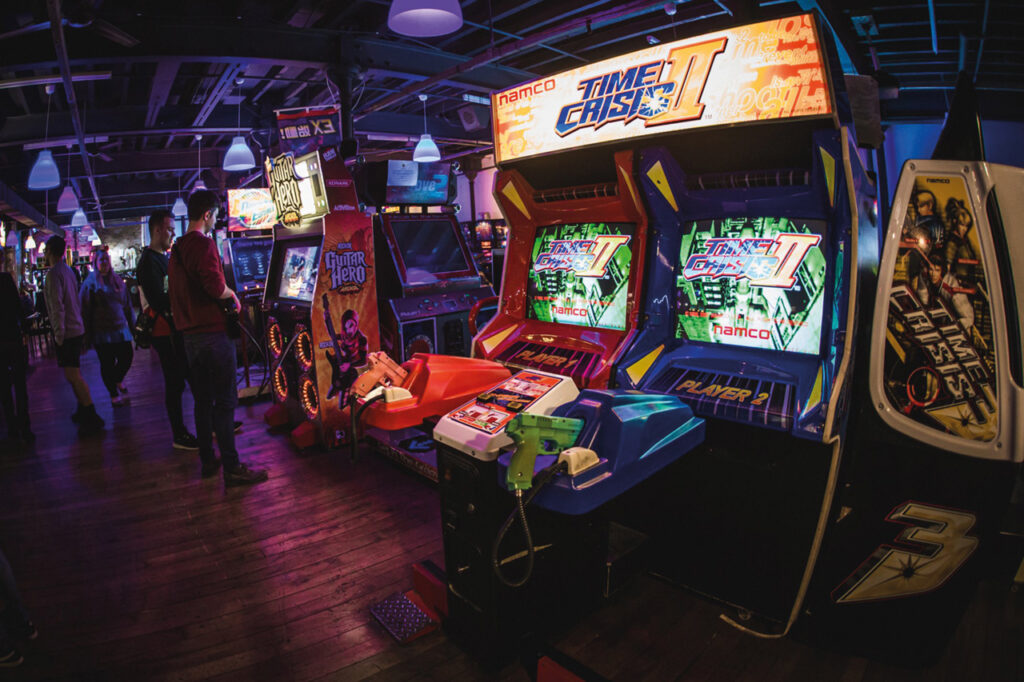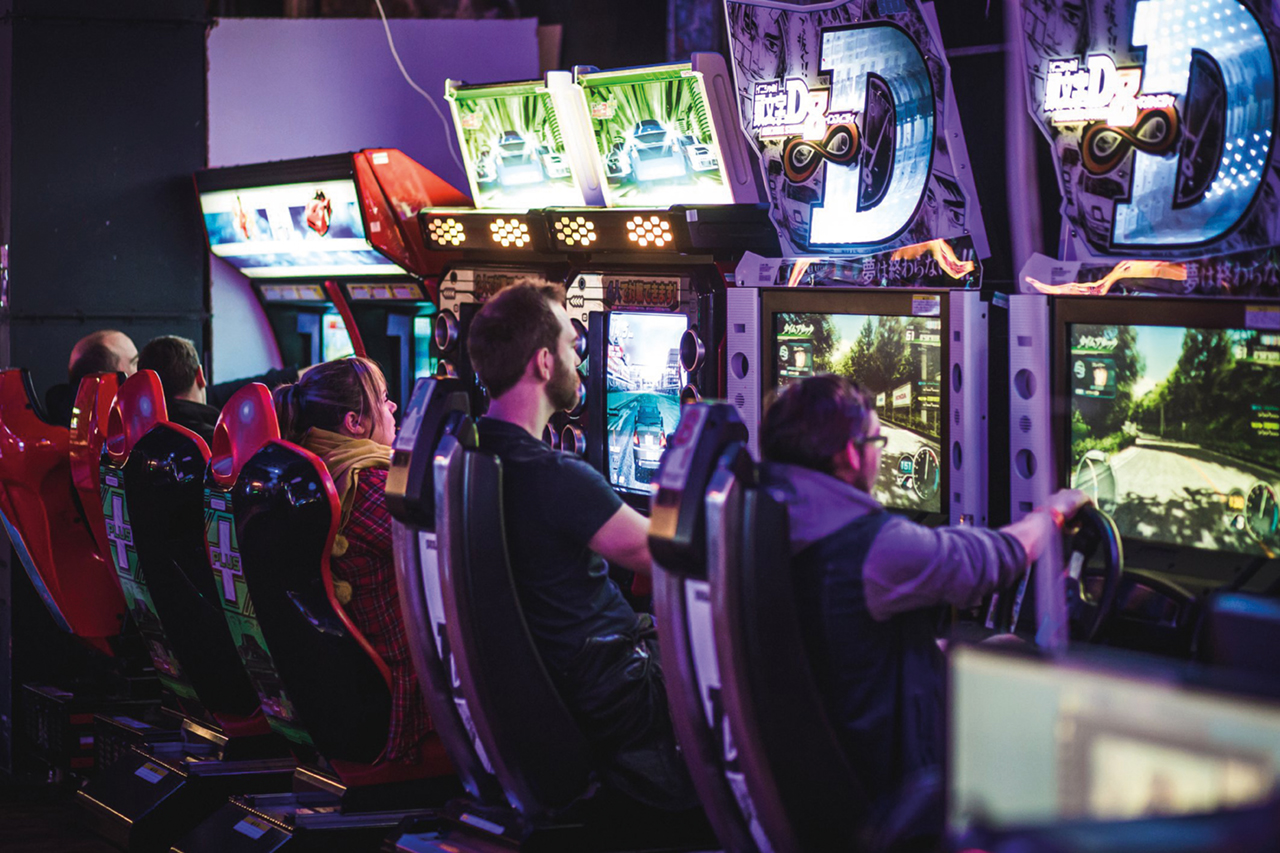Top of the leaderboard
It started off as a private collection of pinball machines at the back of a computer shop in Rossendale. Now it’s a big kids’ paradise spread over multiple floors and three Northern locations
From the outside, it resembles a typically unassuming former mill, but step inside and you feel like you’ve been transported to the neon-hued 1980s Palace Arcade from Stranger Things. Sprawled across four floors, Bury’s Arcade Club is Europe’s largest free-play venue for titles like Pac-Man and Donkey Kong, featuring over 300 coin-operated and pinball machines nosily squabbling for attention.
Since it first opened here in 2015, Arcade Club has attracted visitors from as far as Australia and the US, with forty and fifty-somethings frequently punch-drunk on nostalgia.
“They come in and they’re overawed,” beams owner, Andy Palmer proudly. “We know when people visited arcades as a child when you see them wandering around the top floor in a daze – they can’t believe they’re seeing the machines they saw in their youth. When they look at the screens, they’re seeing their 12-year-old selves staring back at them. It can be emotional for them.”
You can see why gamers are dazzled. The first floor houses a mixture of family-friendly games like Sonic the Hedgehog-branded basketball simulators, alongside current consoles that host tournaments on the latest fighting titles and Fortnite. It also contains Arcade Club’s most expensive purchase – a rare £25,000 four-player Mission Impossible game, one of only two in the country. Walk up the stairs – its walls are festooned with classic gaming icons such as the ghosts from Pac-Man – to the second floor, and you’ll discover modern arcade games, and a gaggle of die-hard dancers’ feet hitting a dozen glowing arrows per second, as they duke it out on the imported Japanese rhythm machines. A recently opened fourth area, located on the ground floor, features newer machines, such as Mario GT, alongside VR Agent, a virtual reality title bequeathed to the venue from Sega.
But it’s clear that the top floor – based on Palmer’s trips to the arcades in the eighties when they were the only place to experience cutting-edge technology – is his pride and joy. Rows of classic games like Mortal Kombat, Snow Bros and Asteroid spark a Proustian button-mashing rush – one that’s enhanced by the smell of ozone, the electricity from the cathode ray tubes permeating the air.
“We designed the top floor in such a way that you feel like you’re back in an eighties/nineties arcade,” enthuses Palmer. “The layout’s the same as what you’d expect, the machines are the same, it even smells like an old arcade. It’s all part of the experience. People bring their grandchildren here to introduce them to gaming.”
From the 1970s to the 1990s, arcades offered three unique things: advanced graphics, a social experience, and novel methods of play – for example, Atari’s 1985 deliver ’em up Paperboy featured bike handlebars as the controller, while Sega’s 1990s flight simulator G-LOC: Air Battle allowed strapped-in players to spin 360 degrees. But as home console graphics caught up and competitive gaming moved online, arcades started dying. There were around 1,000 operating in the UK in the 1980s, but that number had halved by 2011, according to the British Amusement Catering Trade Association.
Unexpectedly, that original tangible sense of community has flourished at Arcade Club, whose regulars know each other by their three-initial nicknames that flash out on the leaderboards like a glowing hall of fame.
“It’s a safe environment to meet because a lot of people in their forties don’t want to go out to nightclubs where they’ll feel like people’s granddads,” says Palmer. “But this is a place people of a certain age can come and feel you do belong, because it’s your youth you’re reviving, which everyone wants to do. Everyone wants to go back to before mortgages and kids, when life was easy. This gives you a snippet of your past which people love.”
Additionally, there’s the spectacle of watching people play. When veteran Sega designer Yu Suzuki devised the “taiken” or “body sensation” games of the late 1980s, such as OutRun and Space Harrier, he sought to tempt non-players into arcades who would enjoy witnessing people play as performance. That idyllic notion lives on in the various tribes who’ve congregated around Arcade Club.
“We have a dance community who play the rhythm games that we import from Japan, and watching them throw shapes is truly impressive,” says Palmer. “We have a community who play all the old games as well, like Track and Field, who were standing around in arcades together back in the 1980s and 1990s. They have a great time – they’re always competing against each other.”
As he repairs a broken-down Ms Pacman cabinet as we talk (very much the yellow rotund glass ceiling-breaking Emmeline Pankhurst of seventies arcade maze-traversing and ghost-munching), it’s obvious that Arcade Club is a labour of love for Palmer, who first became enamoured with gaming in 1983 when he received a ZX Spectrum and the die was cast.
Eight years ago, he started Arcade Club at the back of his family-run computer shop in Rossendale, where he’d charge £10 for refreshments and four hours of free-play on his collection of around 30 pinball machines and arcade cabinets. Whereas the amusements business has been in decline, with venues relying more heavily on 2p machines, claw cranes, and ticket-redemption games, Palmer’s Arcade Club has gone from strength to strength, with further locations having opened in Leeds and Blackpool – perhaps the UK’s spiritual home of arcades.
Arcade Club is also responsible for nurturing champions. Its unique set-up – everything is free to play once you’ve paid a £16 entry charge – helped David Lyne from Bury become the world record holder at 1979 shoot ’em up Galaxian, after racking up a formidable 2,010,000 points in 2015.
“If there was an Olympics for arcades, he would represent the UK,” says Palmer.

Every week, the Twin Galaxies Intergalactic Scoreboard, the global gaming leaderboard, is inundated with footage of purported highest scores from vintage games for its referees to scrutinise (their rigorous rules explain some customers filming their gaming sessions at Arcade Club), but what keeps players chasing new records on titles that are sometimes nearing50 years old?
“These games were designed to play well and keep you putting money in,” he says. “If a game offered a poor gaming experience, it wouldn’t make enough money for the operator so there’s an addictiveness built into them. They’re very raw – rather than just resting on amazing graphics, they had to rely on what they actually feel like to play.”
From the proliferation of bars offering retro games to the success of the Sonic the Hedgehog film series, and upcoming Chris Pratt-led Super Mario Bros movie, why is retro gaming proving so popular among modern sophisticated players? We often think of video games as something for children – or at least, teenagers – that you “grow out of” as you age, notes Nick Bowman, associate professor of journalism and creative media industries at Texas Tech University, but the average age of a gamer in Europe is now 31, with old-age gamers, or OAGs, representing the fastest-growing sector in the UK’s computer gaming market.
According to Bowman’s research, video game nostalgia has the benefits of making people feel closer to their past, their friends and family and themselves, even helping ward off dementia.
“Broadly speaking, we’re seeing that nostalgia can serve as a temporary source of psychological wellbeing,” says Bowman. “Nostalgia is understood as a bittersweet but mostly positive memory from our past, and those memories tend to be very autobiographical, and they can make us feel better connected – both to ourselves, but also the important people from our lives. Those positive memories can be a welcome distraction from present-day stressors.”
Nostalgia tends to act as a balm in times of turmoil, he adds – “until people remember how hard old games can be!”
Some of the responses Bowman received in his research were emotional. One participant recalled how his dad died when he was aged 10 and said: “Playing Mario Kart with him is one of the best memories that I have.”
“While video games are a strong trigger for nostalgia, the nostalgia itself wasn’t always about the video games – people often focused more on the important people in those memories, friends and families, than they focused on the video game itself,” says Bowman.
“As gamers age, they also share this hobby with their own children. It’s increasingly common to see parents and children playing video games together, including classic and retro games – mum and dad can dust off the ol’ Mega Drive just like our parents dug out their old vinyl records for us. These experiences allow for historical nostalgia, in which younger gamers think about bygone video game properties of yesteryear.”
As a child of the 1990s, I’m Arcade Club’s prime audience. I remember little about my university degree, but I can recall the level select cheat code from Sonic the Hedgehog off the top of my head (up, down, left, right, hold down button ‘A’ and press start).
During my childhood, I put more money into these machines than the combined wealth of Davos, so walking into Arcade Club and hearing the siren song of racing game Daytona USA’s wailing theme tune, I feel I’ve hit the jackpot.
And here’s the thing: classic films are regularly given cinema re-releases, so you can appreciate them how they were intended to be experienced, so why shouldn’t the same happen with arcade games?
“The first commercially successful video game, Pong, debuted in bars in California and the game fit in perfectly among darts and other pub games,” notes Bowman. “Arcade Club represents a full circle for video games. What started as a public display of challenge and camaraderie has again found a home.”

Leave a reply
Your email address will not be published.